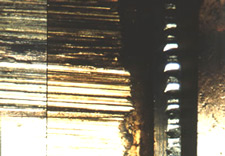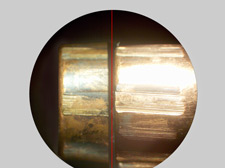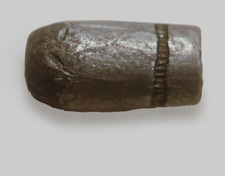Home | Glossary | Resources | Help | Contact Us | Course Map
Archival Notice
This is an archive page that is no longer being updated. It may contain outdated information and links may no longer function as originally intended.
AFTE Range of Conclusions
Based on the AFTE Theory of Identification, there are four categories of examination outcomes (AFTE Range of Conclusions Possible When Comparing Toolmarks) typically used by firearm examiners in the microscopic comparison of fired bullets. Laboratory protocols determine how final conclusions are reported.
The following categories are accepted for all types of toolmark comparisons:
- Identification
- Inconclusive
- Elimination
- Unsuitable for comparison
Identification
The AFTE Glossary defines identification as:
"Agreement of a combination of individual characteristics and all discernable class characteristics where the extent of agreement exceeds that which can occur in the comparison of toolmarks made by different tools and is consistent with the agreement demonstrated by toolmarks known to have been produced by the same tool."
This statement reflects the concepts of sufficient agreement and best known nonmatch. All identifications are based on pattern matching. It is possible to go beyond this qualitative match to the quantifiable consecutive matching striae (CMS) approach to further support an identification.
Inconclusive
An inconclusive result is defined as the outcome of a comparison in which there is
- some agreement of individual characteristics and all discernable class characteristics, but insufficient for identification,
- agreement of all discernable class characteristics without agreement or disagreement of individual characteristics due to an absence, insufficiency, or lack of reproducibility,
- agreement of all discernable class characteristics and disagreement of individual characteristics, but insufficient for an elimination.
Elimination
As defined in the AFTE Glossary, elimination is a significant disagreement of discernable class characteristics and/or individual characteristics. For fired bullet comparisons, an elimination is normally based on observed differences in any one of the general rifling characteristics.
However, an elimination based on individual characteristics is more complex. If it can be shown that a firearm has not been subjected to significant use or abuse over the period of time following the questioned shooting, the qualitative aspects of the striations (e.g., fineness, coarseness) it produces on fired bullets should remain the same. A difference in these striations indicates an elimination.
Elimination based on individual characteristics requires a detailed knowledge of the history and treatment of the firearm, as well as documentation to support the history. It is the responsibility of the examiner to provide this historical documentation. This type of elimination should be approached with caution. Many experienced examiners have never made such an elimination and the protocols of many laboratories do not allow it.
Unsuitable
Fired bullets in this category are determined to be unsuitable for comparison.
This outcome is appropriate for fired bullet fragments that do not bear microscopic marks of value for comparison purposes.
These may be
- fired bullet fragments,
- jacket fragments,
- lead bullet cores,
- lead fragments,
- other portions of fragmented, mutilated, or otherwise damaged bullets
- metallic fragments that cannot be identified as having been a part of a fired bullet (often the product of crime scene searches where all small metal items were collected).
Additional Online Courses
- What Every First Responding Officer Should Know About DNA Evidence
- Collecting DNA Evidence at Property Crime Scenes
- DNA – A Prosecutor’s Practice Notebook
- Crime Scene and DNA Basics
- Laboratory Safety Programs
- DNA Amplification
- Population Genetics and Statistics
- Non-STR DNA Markers: SNPs, Y-STRs, LCN and mtDNA
- Firearms Examiner Training
- Forensic DNA Education for Law Enforcement Decisionmakers
- What Every Investigator and Evidence Technician Should Know About DNA Evidence
- Principles of Forensic DNA for Officers of the Court
- Law 101: Legal Guide for the Forensic Expert
- Laboratory Orientation and Testing of Body Fluids and Tissues
- DNA Extraction and Quantitation
- STR Data Analysis and Interpretation
- Communication Skills, Report Writing, and Courtroom Testimony
- Español for Law Enforcement
- Amplified DNA Product Separation for Forensic Analysts




